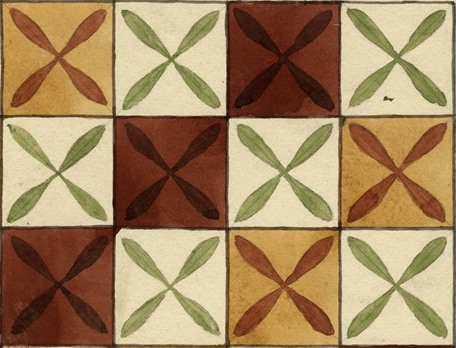The Tomb of Djehutinakht at Deir el-Bersha. Hall. Ceiling.
Ceiling decoration
Reconstruction with Griffith Institute Watercolours
In the ancient Egyptian tombs of the elite it was customary to decorate the walls with scenes of daily life, especially those which illustrated agriculture and industry. Depictions of funerary rites or worshipping of gods assisted the tomb owner's transition to the Afterlife, and vignettes showing the deceased hunting and feasting emphasise their intention to continue enjoying the benefits of their elevated status for eternity.
It is usual to find at the top of walls framing scenes, dedicatory inscriptions and kheker-friezes, and sometimes decoration was extended to the ceiling as well. Attractive ceiling designs included architectural elements painted to imitate wood or hard stone such as granite, both prohibitively expensive building materials, animal and plant motifs repeated multiple times within a chequerboard style grid arrangement, or even grapevine canopies 'growing' across the chamber.
|
Griffith Institute w&d 165, 166, 167 & Griffith, F. Ll. and Newberry, P. E. El Bersheh ii, pl. v
© Griffith Institute Watercolours & Drawings Project | Deir el-Bersha |
Enlarge Powered by Zoomify |
We are indebted to our Griffith Institute Research Volunteers, Lee Young and John Wyatt, who compiled the catalogue for these watercolours, and also to Dr Jaromir Malek, former Keeper of the Griffith Institute Archive, who initiated the cataloguing and digitization of this collection. Helen Murray, the first Keeper of the Archive, accessioned, numbered and arranged the watercolours in their present order.
The digitization of the watercolours was carried out by Jenni Navratil, the Institute's Digital Imaging Officer, assisted by Hana Navratilova. Francisco Bosch-Puche, Alison Hobby and Cat Warsi have all made significant contributions to all stages of this project. Elizabeth Fleming edited the final catalogue and designed the web page content.
A special thank you is extended to our colleagues at the Egypt Exploration Society in London for permission to use the line drawings published in F. L. Griffith & P. E. Newberry El Bersheh ii [1895].



